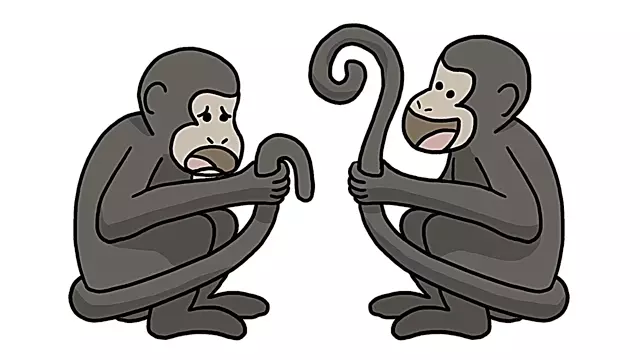2016-11-16
[public] 849K views, 15.6K likes, dislikes audio only
Almost all mammals with prehensile tails live in the neotropics because the forest is different there.
Thanks to http://www.audible.com/minuteearth for sponsoring this video.
Thanks also to our supporters on https://www.patreon.com/MinuteEarth :
___________________________________________
Credits (and Twitter handles):
Script Writer: David Goldenberg (@dgoldenberg)
Script Editor: Kate Yoshida (@KateYoshida)
Video Illustrator: Ever Salazar (@eversalazar)
Video Director: Kate Yoshida (@KateYoshida)
Video Narrator: Kate Yoshida (@KateYoshida)
With Contributions From: Henry Reich, Alex Reich, Emily Elert, Peter Reich
Music by: Nathaniel Schroeder: http://www.soundcloud.com/drschroeder
Image Credits: Spider Monkey - Wikimedia user Petruss
https://commons.wikimedia.org/wiki/File:Ateles_fusciceps_Colombia.JPG
Capuchin Monkey - Steve Jurvetson
https://www.flickr.com/photos/jurvetson/4238921909/
Guianan Saki - Wikimedia user Skyscraper
https://commons.wikimedia.org/wiki/File:White-faced_Saki_2008-07.jpg
Emperor Tamarin - TheBrockenInaGlory
https://commons.wikimedia.org/wiki/File:Emperor_Tamarin_SF_ZOO.jpg
Aotus nigriceps - Wikimedia user Miguelrangeljr
https://commons.wikimedia.org/wiki/File:Aotus_nigriceps.jpg
_________________________________________
Like our videos?
Subscribe to MinuteEarth on YouTube: http://goo.gl/EpIDGd
Support us on Patreon: https://goo.gl/ZVgLQZ
Also, say hello on:
Facebook: http://goo.gl/FpAvo6
Twitter: http://goo.gl/Y1aWVC
And find us on itunes: https://goo.gl/sfwS6n
___________________________________________
FYI: We try to leave jargon out of our videos, but if you want to learn more about this topic, here are some handy keywords to get your googling started:
Prehensile Tail: An animal tail that can grasp or hold objects. A wide range of animals have prehensile tails, including mammals (like opossums and kinkajous), reptiles (like chameleons), amphibians (like salamanders), and fish (seahorses).
Old World Monkeys (Cercopithecidae): A family of primates native to Africa and Asia that includes baboons, guenons and macaques – all of which have non-prehensile tails.
New World Monkeys (Platyrrhini): A family of primates native to Central and South America that includes spider monkeys, howlers, and capuchins – all of which have prehensile tails.
Prehensile tails evolved twice in new world monkeys: In atelines (spider monkey and howlers) the prehensile tail tip is like a finger and incredibly dextrous. In cebines (capuchin monkeys) the tip is furry and not quite as dextrous.
Species featured in this video:
- Spider Monkey (and Diddy Kong!)
- Ficus insipida (tripical fig tree)
- Barbary Macaque (from Northern Africa)
- Rhesus Macaque(from India)
- Opossum
- Chameleon
- Salamander (Aneides lugubris)
- Seahorses (actually Horsea!)
___________________________________________
References:
Glander, K. (2016). Personal Communication
Organ, J. (2016). Personal Communication
Emmons, L.H., Gentry, A.H. (1983). Tropical Forest Structure and the Distribution of Gliding and Prehensile-Tailed Vertebrates. The American Naturalist 121-4 (513-524). Retrieved from https://www.jstor.org/stable/2460978?seq=1#page_scan_tab_contents
Lambert, T., Halsey, M. (2015) Relationship Between Lianas and Arboreal Mammals: Examining the Emmons–Gentry Hypothesis. Ecology of Lianas (398-406).. Retrieved from: http://onlinelibrary.wiley.com/doi/10.1002/9781118392409.ch26/summary
Deane, A., Russo, G., Muchlinski, M., Organ, J. (2014). Caudal Vertebral Body Articular Surface Morphology Correlates With Functional Tail Use in Anthropoid Primates. Journal of Morphology 275 (1300-1311). Retrieved from http://onlinelibrary.wiley.com/doi/10.1002/jmor.20304/abstract
https://www.patreon.com/minuteearth
/youtube/video/48mDorFzXYA
/youtube/video/isorFmeW-f4?t=12.19
/youtube/video/isorFmeW-f4?t=45.219002
/youtube/video/isorFmeW-f4?t=115.94
/youtube/video/4DF94Wvtekk
/youtube/channel/UCeiYXex_fwgYDonaTcSIk6w
https://www.patreon.com/minuteearth

